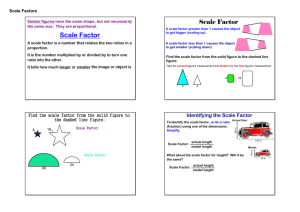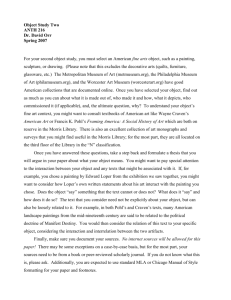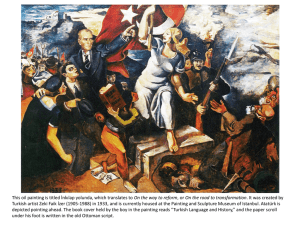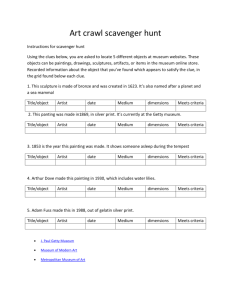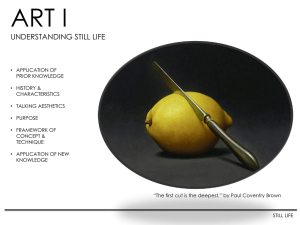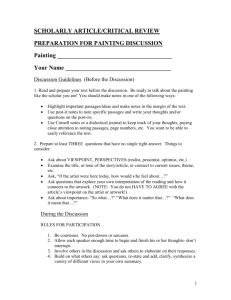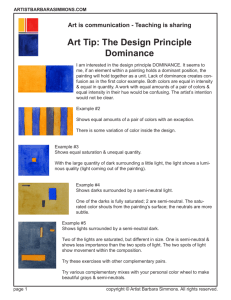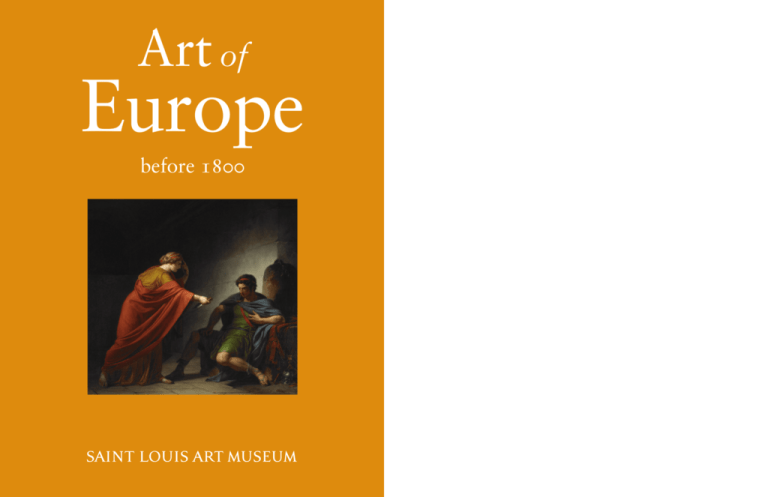
Art of
Europe
before 1800
Art of
Europe
before 1800
Table of Contents
The materials in this curriculum packet are designed to be used by students
of all ages and their teachers. The entire packet is available as an interactive
program on the Museum’s website at www.slam.org/teachers
We would appreciate your comments on these materials. Please log onto the
Museum’s website at www.slam.org/packetevaluation to complete the online
evaluation form.
This curriculum packet contains the following items:
• Posters of seventeen artworks from the collection of the Saint Louis Art Museum.
Each poster offers information about the work of art and suggested questions for
discussion with younger and older students.
• A Teacher’s Guide, which includes images, learning activities, and an annotated
list of source materials.
We encourage classes to visit the Museum to view the works in this curriculum
packet. Tours are free and may be scheduled for groups (pre-kindergarten through
adults). All groups, whether led by a Museum docent or self-guided, must
pre-register with the Museum to assure time in the designated galleries.
To schedule a tour, complete the tour request form on the Museum’s website
at www.slam.org/teachers or call the tour hotline at 314.655.5484.
Please allow four weeks notice.
Project Team
Bill Appleton, Assistant Director for Public Programs and Education
Ann Burroughs, Education Assistant
Louise Cameron, Director of Educational Media
Judith W. Mann, Curator of European Art to 1800
Michael Murawski, Director of School Services
Mary Nichols, Associate Educator
Erika TenEyck, Associate Educator
Written by Louise Cameron, Erika TenEyck, Ann Burroughs,
and Bill Appleton, with assistance from Michael Murawski,
Marianne Cavanaugh, Clare Vasquez, and Mary Nichols
Edited by Louise Cameron and Fontella Bradford
Designed by Lauri Kramer
Introduction
4
Diptych with Scenes of the Passion and Afterlife of Christ
6
Madonna and Child Enthroned with Saints Peter,
John the Baptist, Dominic, and Nicholas of Bari
7
St. Eustace
8
Field Armor
9
Reclining Pan
10
Mary, Lady Guildford
11
Judith and Holofernes
12
Christ Shown to the People (Ecce Homo)
13
Apollo and Marsyas
14
Still Life with Mice
15
Christ Presented to the People (“The Ecce Homo”)
16
The Account Keeper
17
Bust of a Black Man
18
Interior of St. Peter’s, Rome
19
Pair of Vases from the Swan Service
20
Arria and Paetus
21
A Harbor in Moonlight
22
Learning Activities keyed to the Missouri Grade
Level Expectations for Visual Arts
23
Suggested Resources
26
Useful Websites
28
Copyright 2009 Saint Louis Art Museum
cover image:
François-André Vincent, French, 1746–1816
Detail of Arria and Paetus, 1784
oil on canvas
39 ¾ x 48 inches
Funds given by Mr. and Mrs. John Peters MacCarthy, Director’s Discretionary Fund,
funds given by Christian B. Peper, and gift of Mr. Horace Morison
by exchange 27:2008
2
3
Introduction
Who were the great masters of early European art?
You might answer with famous names like Leonardo
da Vinci, Michelangelo, Caravaggio, Rembrandt, and
Jacques-Louis David. But there were many other talented
individuals who responded to changing ideas in science,
religion, and politics during the period from the
thirteenth through the eighteenth century. This packet
features seventeen works selected from the Saint Louis
Art Museum’s collection of European Art to 1800,
encompassing Gothic, Renaissance, Baroque, Rococo,
and Neoclassical styles. These objects demonstrate the
importance of art in European culture, and reveal the
power of art to tell stories.
During this early period, artists in Europe looked to the
past and based their works on forms established by the
ancient Greeks and Romans. Because this was a great age
of discovery, painters and sculptors also experimented
with new techniques and styles. Many factors influenced
art in Europe before 1800, but one theme remained
strong—visual storytelling. Stories from the Bible,
mythology, and literature, fantastic creatures and sacred
figures, important individuals and everyday citizens
all came to life through art. In this packet we examine
some of the ways this period approached art as a form
of storytelling.
The Christian church was one of the most significant
influences on early European art. Because many congregants were not able to read, the Church used painting,
sculpture, and other art forms to present its literature
and litany. The ivory diptych, Scenes of the Passion and
Afterlife of Christ (poster 1) is a small portable
masterpiece that was used for personal worship. Its form
is inspired by Gothic architecture.
A much later work also reflects the influence of church
architecture. During the eighteenth century, wealthy
men and women began to travel on the Grand Tour, an
extended journey to Italy to view the great masterpieces
of ancient Rome and the Renaissance. Painted representations of well-known tourist sites were popular mementoes
4
for these travelers. In Giovanni Paolo Panini’s Interior
of St. Peter’s, Rome (poster 14) a variety of people interact
in a grand architectural setting.
Images sacred to Christians remained dominant in
European art through the fifteenth and sixteenth
centuries. Titian’s Christ Shown to the People (Ecce
Homo) (poster 8) gives us the artist’s vision of Christ just
hours before his death. Piero di Cosimo’s Madonna and
Child Enthroned with Saints Peter, John the Baptist,
Dominic, and Nicholas of Bari (poster 2), incorporating
the Pugliese coat of arms, was placed in a private chapel
where it bore witness to the family’s faith and devotion
as well as their financial status.
Works based on Biblical tales of heroes and heroines
inspired Renaissance viewers. Giorgio Vasari’s Judith
and Holofernes (poster 7) portrays a dramatic moment
from the tale of a Jewish widow whose bravery saved
her town. Judith’s bulging muscles and dynamic pose
depict female form using a super-human vocabulary.
Heroes and heroines depicted in art were not always
Christians. The excavation of the ancient Roman city of
Pompeii in 1748 revived Europe’s interest in mythological
legends and political sagas meant to inspire patriotism
and instill lessons of virtue and honor. Arria and Paetus
(Poster 16) with its dramatic lighting, clear lines, and
distinct poses, recalls ancient sculpture. Its subject matter
also teaches a lesson about duty, a virtue valued by
ancient and contemporary audiences alike.
This period also renewed interest in tales of mythological
gods and goddesses, great wars, and bizarre creatures.
Francesco da Sangallo’s Reclining Pan (poster 5) was
inspired by ancient sculpture and created from recycled
ancient marble. Bartolomeo Manfredi’s Apollo and
Marsyas (poster 9) tells the story of a god’s revenge on
an arrogant rival.
In Northern Europe at this time, artists used precise
details to convey narrative content. Mary, Lady Guildford
(poster 6), painted in England by northern artist
Hans Holbein the Younger, features the subject in a
sumptuous costume suited for a noblewoman. With great
skill, the artist recreated textures such as the fine gold
thread of the fabric. Lady Mary’s pose, accessories, and
expression convey her status as a member of the nobility.
Portraits tell stories about their subjects, but sometimes
research reveals interesting clues about their creation
as well. Bust of a Black Man (poster 13) was executed
during the time when the artist Melchior Barthel was
working on a tomb sculpture. The subject of the bust
may well have been one of his models for the larger,
more elaborate project.
With the invention of the printing press by Johannes
Gutenberg in the mid-fifteenth century, religious texts,
ancient prose, and other works could be widely circulated.
Prints became an affordable alternative to more costly
works of art. Albrecht Dürer’s innovative technique
and eye for detail pushed the boundaries of printmaking
to new levels. One of Dürer’s largest prints, St. Eustace
(poster 3), sets the stage for the saint’s conversion through
myriad details of plants, animals, and landscape.
One hundred and fifty years after Dürer created
St. Eustace, Rembrandt, working in a similar medium
in the Netherlands, completed Christ Presented to
the People (“The Ecce Homo”) (poster 11). The main
figures, Christ, Barabbas, and Pontius Pilate, appear
on an elaborate stage at a decisive moment in the
dramatic series of events. Again the artist includes
details that encourage us to look closely at the print
to interpret its story.
artists, Susi and Maes painted highly detailed works
that exhibited their skill at representing surface textures
and the play of light on objects.
Another artist who demonstrated his skill at treating
light was Joseph Vernet, whose landscape scene, A Harbor
in Moonlight (poster 17), depicts the busy port of Naples
at night. Using several light sources, the artist portrays
an actual place with poetic sensibility.
Decorative arts, including metalwork, reveal stories of
how things were made. The steel Field Armor (poster 4)
was engineered to provide the greatest amount of
flexibility and protection during a battle. The porcelain
Pair of Vases from the Swan Service (poster 15) was part
of an extravagant gift that can still tell us about the
wealth and status of the donor as well as the recipient.
Both works help us visualize everyday life in early times.
As you can see, the objects featured in this packet
represent only a sample of the incredible works of art
in the Museum’s collection of early European art. We
encourage teachers and students to explore additional
paintings, sculpture, decorative arts, and works on
paper by visiting the Saint Louis Art Museum to look
for stories in the art.
During the sixteenth and seventeenth centuries, Protestant
reforms reduced the demand for sacred art works in the
Netherlands. Patrons showed a great interest in the
objects and events of everyday life, and artists responded
by producing paintings such as Lodewik Susi’s Still
Life with Mice (poster 10) and Nicholaes Maes’s genre
painting, The Account Keeper (poster 12). Like many
5
1
This intricate object with columns and towers is like a
tiny cathedral made from elephant ivory. Pointed arches
which enclose each of the eighteen scenes are typical of
Gothic architecture, a prominent building style in France
in the thirteenth century. This diptych (DIP-tick) with
two hinged parts would have been used during personal
prayer in a private setting such as a bedroom. The scenes
tell the story of Jesus Christ’s last days on earth. In the
bottom row, from left to right, is the story of Judas’s
betrayal of Jesus with a kiss and Judas’s suicide by
hanging; the middle row is made up of events from
the Crucifixion and burial; and the top row shows the
resurrected Christ appearing to his followers. In the
final scene in the top right corner we see Jesus’s feet as
he ascends bodily into heaven.
6
2
French
Diptych with Scenes of the Passion and Afterlife
of Christ, 1250–70
Piero di Cosimo, Italian, 1461/62–1521(?)
Madonna and Child Enthroned with Saints Peter, John
the Baptist, Dominic, and Nicholas of Bari, c.1481–85
elephant ivory with traces of paint
8 3/16 x 7 1/16 x 3/8 inches
Museum Purchase 183:1928
tempera and oil on panel
66 1/4 x 44 1/8 inches
Museum Purchase 1:1940
For younger students:
There is one figure that appears in many of the scenes.
Can you find him? What is he doing in each scene?
If you were going to make a diptych, what materials
would you use?
For older students:
The diptych was once painted. How would this affect
your reaction to the work?
What does the shape and appearance of the diptych
remind you of? Explain some reasons for your answer.
This large painting featuring the Virgin Mary, baby Jesus,
and four saints was once in a private chapel belonging
to the Pugliese (Pool-YAZE-ee) family. Their coat of
arms is in the frame’s lower corners. In the large central
painting, Mary and the baby are sitting on a raised throne
as Saints Peter and John the Baptist introduce the other
two holy figures, Saints Dominic and Nicholas of Bari
(BAR-ee). We can recognize the figures by their clothes
and the objects they hold: Peter has two keys; John the
Baptist wears a brown animal skin; Nicholas of Bari,
dressed in green and red, holds three gold balls; and a
white lily appears above Dominic’s shoulder. The saints’
poses and gestures direct our eyes to Jesus, who raises his
hand in a sign of blessing. Dominic, John, and Nicholas
also appear in the three smaller paintings along the
bottom which show scenes from their lives.
For younger students:
Is this painting symmetrical or asymmetrical? Why?
What do you imagine each of the characters is saying
in this painting?
For older students:
Describe some examples of symmetry in the painting.
Be sure to include the frame in your discussion.
This painting is called a sacred conversation because the
figures all communicate with each other in some way.
Name some of the ways.
7
4
3
Wilhelm von Worms the Elder (active 1497–1537)
and others, Nuremberg and Landshut, Germany
Field Armor, 1510–25
Albrecht Dürer, German, 1471–1528
St. Eustace, c.1501
steel, leather, and modern restorations
68 x 30 1/2 x 19 inches
weight: 40 lb. 15 oz.
Museum Purchase 171:1926a–n
engraving
plate (irregular): 14 x 10 3/16 inches
Museum Purchase 255:1916
In this work we see five dogs, a horse, and a man.
According to the story, Placidus (PLA-sid-us), a Roman
general, was hunting when he saw a deer with a glowing
crucifix between its antlers. This vision led Placidus to
fall on his knees and convert to the Christian faith. At
that time he took the name Eustace. In this print we see
Albrecht Dürer’s (DER-er’s) fascination with depicting
things from nature—trees, flowers, grass, and surface
textures like animal fur. The artist made this engraving
by cutting grooves into a metal plate. Ink was applied
to the plate, which was wiped leaving ink in the grooves,
then covered with paper and run through a printing
press. This technique allowed Dürer to create amazing
details using a variety of lines and tones. His innovative
approach to printmaking made Dürer one of the most
influential artists of the Renaissance.
8
For younger students:
Name all of the animals you see.
Imagine that you are in this picture—what would you
be doing?
For older students:
Imagine yourself in the picture. Starting in the foreground,
describe how you would walk through the middle
ground to get to the castle in the background.
What elements of art—line, color, shape, texture—does
the artist use and how?
Full suits of armor were worn by men on horseback for
protection during battle. Custom-made to fit the owner,
this suit is composed of separate sections that shield
individual body parts. Some of the components, such as
the gauntlet that covers the hand, are made up of small
pieces of steel to provide flexibility and movement.
Larger sections have surface flutes, or raised lines, that
add rigidity and help deflect weapons. A lance or long
spear would have rested on the curved hook near the left
shoulder. Young squires or assistants helped the rider
put on the forty-pound suit of armor. Leather straps at
the shoulders, waist, wrists, and knees kept it in place.
Armor’s appearance was influenced by fashion trends
of the day. The wide-toed foot coverings of this suit were
based on popular footwear for men.
For younger students:
Make up a very short story in which this suit of armor
plays a role.
Name some things you would not be able to do if you
were wearing this suit of armor.
For older students:
Which of your five senses would be affected by wearing
this suit of armor? Describe each and tell how the
wearer could compensate.
Think of some things we wear today for defense in
sports or war. Are any similar to the Field Armor?
9
5
6
attributed to Francesco da Sangallo, Italian, 1494–1576
previously attributed to Giovanni Angelo Montorsoli, Italian, 1507–1563
Reclining Pan, c.1535
Hans Holbein the Younger, German, 1497/98–1543
Mary, Lady Guildford, 1527
marble
52 3/4 x 25 x 23 1/4 inches
Museum Purchase 138:1947
oil on panel
34 1/4 x 27 13/16 inches
Museum Purchase 1:1943
Pan lies on a rocky bed surrounded by vines, grape
clusters, and a slithery salamander. Carved from marble
in this sculpture, Pan the satyr (SAY-ter)—a half-human,
half-goat creature of mythology—is very well known
for his bad behavior. This god of forests, mountains,
flocks, and shepherds lives in the woods and often carries
a reed pipe (seen here in his right hand). The pipe refers
to the story of Pan and the maiden Syrinx (SEAR-inks).
One day Syrinx saw Pan in the woods. She knew of his
reputation and decided to run away before he could talk
to her. Reaching a river that was too dangerous to cross,
she asked the gods for help to escape. They changed her
into a patch of reeds. Pan, heartbroken at losing Syrinx,
picked several of the reeds and made a musical pipe,
playing it in her honor.
10
For younger students:
Write three words you would use to describe the
sculpture of Pan.
Describe the environment in which Pan lives.
Which details from the sculpture would you use
in your description?
For older students:
Would you say this sculpture is real, stylized, or abstract?
Why? (Use details from the sculpture to support
your answer.)
This sculpture once served as a fountain in a garden.
Why would a person want a fountain featuring Pan?
In this portrait, Lady Mary Guildford (GUILD-ford) is
dressed in all the fashionable finery of King Henry VIII’s
English court. She wears a black velvet dress decorated
with six gold chains, fur trim, and sleeves of golden
fabric. Her headpiece, which looks like a building’s
pointed roof, was the height of English style at the time.
She holds a prayer book and a rosary to show that she is
religious. Lady Mary was the wife of Henry Guildford,
whose job was to supervise the King’s finances. As
appropriate for a husband and wife in such favor with
the King, Mary and Henry both had their portraits
prepared by court painter Hans Holbein (HOLE-bine)
in 1527, when Mary was 27 years old. Today Henry’s
portrait is in the Royal Collection at Windsor Castle,
in England.
For younger students:
How many faces do you see in the painting?
If you were going to have your portrait painted, what
would you wear?
For older students:
Describe Lady Mary’s expression, pose, and dress. What
does each suggest about her personality and status?
What are some things people in the twenty-first century
wear to indicate their status?
11
7
8
Giorgio Vasari, Italian, 1511–1574
Judith and Holofernes, c.1554
Titian (Tiziano Vecellio), Italian, c.1485-90–1576
Christ Shown to the People (Ecce Homo), c.1570–76
oil on panel
42 1/2 x 31 3/8 inches
Friends Fund and funds given in honor of
Betty Greenfield Grossman 2:1982
In this painting based on a story from the Bible, the
heroine Judith holds a sword above her head as she
stands over a sleeping man. Judith and her maid Abra
had entered the enemy camp of the Assyrian (A-SEARee-an) army with an offer to reveal secret information.
Pretending to be on his side, Judith requested a meeting
with the general Holofernes (ho-low-FAIR-knees). The
general was captivated by her charm and invited her
to a private feast. After the meal, Holofernes fell asleep.
Judith took advantage of his condition and beheaded
him, leaving the Assyrian forces in chaos. The artist
shows Judith as a woman of great strength and power.
Judith’s dynamic pose, bulging muscles, and militarylike costume highlight her victory. Over time, the story
of Judith has come to symbolize triumph over cruelty
and oppression.
12
For younger students:
Make a list of adjectives that describe the painting.
What do you think happened before or will happen
after this scene?
For older students:
Why do you think the artist chose to portray this
particular moment from the story?
Judith’s courageous act helped save her town from
enemy forces. Name some other women who have
performed heroic deeds.
oil on canvas
43 x 37 5/16 inches
Museum Purchase 10:1936
Although the title of this painting is Christ Shown to
the People, the artist has chosen to depict what happens
before Jesus is actually shown to the crowd. To the right
stands the elderly governor Pontius Pilate (PON-chus
PI-lut), wearing a luxurious costume trimmed with fur
and decorated with jewels. On the left is a young servant,
also dressed in elaborate clothing. In contrast, the bearded
figure of Jesus Christ stands between the two, covered
only in a simple cloth and wearing a crown of thorns.
Christ’s downturned gaze expresses humility; Pontius
Pilate looks off to the right expectantly; the young
boy looks to the right with an expression of animated
anticipation. The simple composition and dark tones
of the painting invite us to contemplate the scene and
speculate on what will come next.
For younger students:
Compare and contrast this painting with Rembrandt’s
Christ Presented to the People (“The Ecce Homo”)
(poster 11).
Choose one of the people in the painting and tell what
you think he was doing before this scene takes place.
For older students:
Some sections of this work are painted in fine detail,
while others are rendered in loose brushwork. Identify
examples of both, and discuss the effect this has on how
you see the painting.
Compare and contrast this painting with Rembrandt’s
Christ Presented to the People (“The Ecce Homo”)
(poster 11). What has each artist chosen to emphasize?
How might the differences in these works change the
way we relate to the event and its characters?
13
9
10
Bartolomeo Manfredi, Italian, 1582–1622
Apollo and Marsyas, 1616–20
Lodewik Susi, Flemish, active 1616–1620
Still Life with Mice, 1619
oil on canvas
37 5/8 x 53 9/16 inches
Friends Fund and funds given by Mr. and Mrs. John
Peters MacCarthy, Phoebe and Mark Weil, and
Christian B. Peper 62:2004
In this painting, Apollo, god of music, poetry, and the
sun carries out a cruel punishment on the satyr Marsyas
(MAR-see-us). According to an ancient myth, Marsyas
believed that he could defeat Apollo in a musical contest.
The stakes were high in this competition since the winner
would decide the loser’s fate. Not surprisingly, the god
Apollo won. He chose a shocking way to punish
Marsyas for his pride—flaying, or peeling off his skin.
This painting shows only the two characters. Marsyas,
who lived in the woods, is shown tethered to the trees
while Apollo, the god, is framed against a brightly lit
sky. In contrast to Apollo’s calm expression, Marsyas
appears shocked and horrified.
14
For younger students:
Compare and contrast the appearance of the two figures.
What do you think will happen next? Will the story
have a happy ending or a tragic one?
For older students:
What if the artist had depicted the figures further
back in the landscape? How would it affect the way
we interpret the painting?
Compare and contrast the figures of Apollo and
Marsyas. What do their similarities and differences
suggest about them?
oil on panel
13 3/4 x 18 5/16 inches
Museum Purchase 50:1949
A lemon, an orange, apples, ginger sticks, and sugared
almonds are shown in this still life. Even though the items
appear randomly strewn on the table, the artist has
actually placed them carefully. The arrangement creates
a series of diagonal lines and color contrasts to form a
balanced composition. (Notice how the red apple and
reflective plate seem to balance the lemon and orange.)
The knife and plate, which hang over the edge of the
table, not only show the artist’s outstanding skills as a
painter, but also bring us into the picture. The decay on
the apple and the presence of mice could suggest another
message to the viewer, since mice sometimes symbolize
death or sin, and rotting food is often a metaphor for
change and mortality. These elements serve to remind
the viewer of life’s transformations and warn against
overindulgences such as sweets.
For younger students:
Name all of the objects in the painting.
Make up a story from the point of view of one
of the mice.
For older students:
Discuss how the artist used the elements of art—line,
shape, color, texture—in this painting.
The food featured here would have been expensive at
the time. What are some costly treats today?
15
11
Rembrandt van Rijn, Dutch, 1606–1669
Christ Presented to the People (“The Ecce
Homo”), 1655
drypoint on Japanese paper
plate (irregular): 15 1/8 x 17 5/8 inches
Museum Shop Fund, Friends Fund, and funds
given in honor of James D. Burke, Museum Director
from 1980 to 1999 by Mr. and Mrs. Lester A.
Crancer Jr., Mr. and Mrs. Christian B. Peper, the
Ruth Peters MacCarthy Charitable Trust, an
anonymous donor, Mary and Oliver Langenberg,
Phoebe and Mark Weil, Sam and Marilyn Fox, The
Sidney S. and Sadie Cohen Print Purchase Fund,
the Julian and Hope Edison Print Fund, Margaret
Grigg Oberheide, an anonymous donor, Mr. and
Mrs. Kenneth F. Teasdale, Mr. and Mrs. John W.
Bachmann, the Anne L. Lehmann Charitable Trust,
Anabeth Calkins and John Weil, Mrs. James Lee
Johnson Jr., Suzanne and Jerry Sincoff, Mr. and
Mrs. Sam Weiss, Mr. and Mrs. Martin E. Galt III,
and Mr. and Mrs. Andrew B. Craig III 1:1999
In this print based on an event in the Bible, the large
crowd and monumental architecture provide a dramatic
setting for the main figures. On the central platform, two
men are shackled next to the governor Pontius Pilate
(PON-chus PI-lut), who wears a turban. Jesus Christ is to
the right, his head bowed while Barabbas (bar-RAB-us),
a criminal, stands between Jesus and Pilate. At festival
time in Jerusalem, it was traditional for the governor to
release a prisoner. Pilate asks the crowd which of the men,
Christ or Barabbas, should be released. It is a pivotal
moment in the story—Christ will not be released and will
instead be crucified. Rembrandt’s composition was made
using the drypoint technique. The artist scratched and
cut directly into a copper plate to produce a variety of
lines. Then the plate was inked, wiped, and run through
a printing press. In this resulting image printed on
special paper, sharp lines contrast with blurred edges
and rich tones.
16
For younger students:
Make up a title that you think best describes this work.
Describe three figures you see in the crowd.
For older students:
Name five ways by which Rembrandt draws attention
to the main characters.
Do you think the artist intended for us to be part of
the scene? Why or why not?
12
Nicolaes Maes, Dutch, 1634–1693
The Account Keeper, 1656
oil on canvas
26 x 21 1/8 inches
Museum Purchase 72:1950
In this painting a woman appears to have fallen asleep
in the middle of her work. She sits with a pile of books
in front of her and holds a quill pen. The pile of books
is sloppy, but the rest of the room is tidy. A large map
of the world hangs on the wall. During this period in
history European countries were exploring the globe,
and people were fascinated by unknown territory. Keys
hang from a nail below the map. The room and objects
in it are typical of a Dutch middle class home in the
1650s. Although the artist gives us few clues as to why
the woman is sleepy, the objects and their arrangement
show that she is part of a household that is orderly and
financially sound.
For younger students:
How many round shapes do you see in the room?
What do you think will happen next in this story?
For older students:
Why is there a sea monster in the map hanging
on the wall?
Which do you think is the primary focus of the
painting—the room or the woman—and why?
17
14
13
Giovanni Paolo Panini,
Italian, 1691–1765
Interior of St. Peter’s, Rome, 1731
Melchior Barthel, German, 1625–1672
Bust of a Black Man, 1660s
marble
24 1/2 x 17 x 8 5/8 inches
Funds given by Mr. and Mrs. R. Crosby Kemper Jr. through the
Crosby Kemper Foundations 54:1990
A bust, one of the oldest types of portraits, traditionally
shows a person’s head and shoulders. Melchior Barthel
(MEL-key-or Bar-TELL) skillfully carved this handsome
bust of an African man, portraying him with a sensitive
expression. The subject here was probably one of the
models who posed for the artist in the preparation of a
larger tomb sculpture. Carved from black marble, the
sculpture’s face and neck are highly polished to contrast
with the textured surface of his close-cropped hair. The
man’s shirt and overcoat are elegantly crafted from white
marble, adding a dramatic element. The bust is attached
to a red marble base that serves as the pedestal. Exotic
materials, contrasting colors, and stylish presentation
illustrate the seventeenth-century preference for works
that express emotion as well as the artist’s skill.
18
For younger students:
What would this sculpture say if it could talk?
What materials would you use to make a portrait
of a friend?
For older students:
Who do you think this man was? Does his clothing
offer any clues?
What are some reasons the artist might have created
this bust?
oil on canvas
57 3/8 x 89 7/8 inches
Museum Purchase 7:1946
Giovanni Paolo Panini (joe-VON-ee PAWL-o
Pa-NEE-nee) produced more than twenty versions
of this painting showing the interior of St. Peter’s
Basilica in Rome. Because they were so portable,
paintings that could be rolled up and carried home
were in high demand among tourists who visited Italy
in the eighteenth century. This painting accurately
records the appearance of the church in almost every
detail. Panini used light and a low horizon line to draw
attention to the central area. He peopled the grand
interior with animated figures, allowing the painting
to become a view of everyday life that tourists would
have seen when visiting the famous church.
For younger students:
How many people do you see in the painting? Describe
what they are doing.
Name some geometric shapes you see throughout
the building.
For older students:
What kind of building is this? What was it used for?
When you visit a special place, how do you remember it?
19
15
16
Johann Joachim Kaendler,
German, 1706–1775
made by the Meissen Porcelain Manufactory,
Germany
Pair of Vases from the Swan Service, 1738
François-André Vincent, French, 1746–1816
Arria and Paetus, 1784
oil on canvas
39 3/4 x 48 inches
Funds given by Mr. and Mrs. John Peters MacCarthy,
Director’s Discretionary Fund, funds given by
Christian B. Peper, and gift of Mr. Horace Morison
by exchange 27:2008
glazed and gilded porcelain with gilded copper-alloy mounts
each: 23 x 11 5/8 x 10 7/8 inches
Museum Purchase 36:1945a,b
Four magnificent swans spread their wings and twist
their necks behind them to form the handles of these
vases. Originally, these two elaborate pieces were part
of a lavish set of dinnerware. Referred to as the Swan
Service, it was a gift presented to a German count in
honor of his wedding. The set consisted of more than
2,000 pieces that could serve up to one hundred guests.
The gold coats of arms on the bodies of the vases were
those of the two families being joined by marriage.
Because swans mate for life, these graceful birds are
often associated with weddings. The Swan Service was
presented to wish the bride and groom a long and
happy life together.
20
For younger students:
Look carefully at the pair of vases; are they exactly
alike? How are they different?
The vases belong to a much larger set of dishes that
would have been used for fancy dinner parties. What
would you use these two vases for?
For older students:
Why did the designer choose to decorate the vases
with swans?
The vases are made out of porcelain. Why do you think
the maker used porcelain instead of silver or bronze?
Arria (ARR-ee-uh) and her husband Paetus (PIE-tus)
look as though they are on a stage performing a scene
from a play. Arria leans forward and points to her head,
ready to plunge the knife into herself; Paetus shrinks in
horror at the thought of imitating Arria’s actions. The
dark background and dramatic lighting emphasize the
drama of their poses and expressions. This painting is
based on ancient Roman history in which Paetus joins
a conspiracy against the emperor. When the plot fails,
Paetus is cast out of Rome. Eventually, he is called back
to the city to be imprisoned. Arria knows that in order to
avoid the shame of going to jail, the only honorable thing
for her husband to do is commit suicide. When Paetus
proves unwilling, Arria seizes the knife to demonstrate.
Arria’s actions would have been seen as courageous in
ancient times.
For younger students:
See if you can pose like one of the two people
in the painting.
What do the two characters’ expressions and gestures
indicate they are each feeling?
For older students:
Why do you think the artist chose to depict this
moment from the story?
Compare the figure of Arria to that of Judith in Judith
and Holofernes (poster 7). Describe some similarities
and differences.
21
Learning Activities
These learning activities are based on the five strands for Visual Arts Grade Level Expectations of the Missouri
Department of Elementary and Secondary Education.
The learning activities listed in this packet are written with middle level students (grades 5—7) in mind, but many
of them can be adapted for other levels.
Art GLEs are grade level benchmarks for the Fine Arts Content Standards in the Show-Me Standards for Missouri
Schools. It is expected that 80% of students will demonstrate proficiency at the GLE level. As school districts build
curriculum documents, it is understood that concepts and skills should be introduced at earlier grade levels, assessed
at the GLE level, and continue to be reviewed/reinforced at later grade levels. At each grade level, students should be
able to demonstrate the GLEs from previous years as well as those specified for the current grade. Emphasis is
placed on skill refinement and increasing control of each medium. Students are expected to grow in their ability to
select art materials which are best suited for creatively communicating their ideas.
17
Joseph Vernet, French, 1714–1789
A Harbor in Moonlight, 1787
oil on canvas
24 x 32 inches
Gift of Christian B. Peper 37:2006
There seems to be a lot of activity in this moonlit scene
based on the harbor of the Italian city of Naples. In the
foreground, a person kneels in a boat and feeds a large
net to two men who stand on the rocky shore. Two others
work with nets in the boat. To the left, a group gathers
around a fire and large kettle. Out in the harbor, giant
sailing ships drop anchor while small rowboats with
passengers hover nearby. A tall tower shines its light
over the harbor, and moonlight glistens on the water’s
calm surface. Vernet, who specialized in painting
harbors, captures meticulous details of the people
going about their tasks as clouds move gently over
the harbor’s calm water.
22
For younger students:
How many different sources of light can you find
in this painting?
Look carefully at the painting and describe the sounds
and smells of the scene.
For older students:
Describe some elements in the foreground, middle
ground, and background.
The scene in this painting takes place at night; are there
other paintings in the packet that also take place at
night? How can you tell?
Strand I Product-Performance
Artists communicate ideas through artworks by selecting and applying media techniques and processes,
subject matter, and themes.
1.A–D Select and apply two-dimensional media,
techniques, and processes to communicate ideas
and solve challenging visual art problems—various
art media.
Using one of the poster images, create a two-dimensional
work of art based on the image but done in a medium
different from the original. (examples: a continuous line
drawing based on Bust of a Black Man or Field Armor;
a linoleum print based on Vases from the Swan Service
or Still Life with Mice) Discuss how the students’ works
differ from the originals.
3.A Communicate ideas about subject matter and
themes in artworks created for various purposes—
subject matter: fine art.
Discuss the arrangement of objects in Still Life with Mice.
Talk about the role of foreground, middle ground and
background, overlap, and size. Then ask students to
arrange a group of simple objects on a table and draw or
paint a still life from observation. Ask students to title
their finished works and write a museum label for each.
23
Strand II Elements and Principles
Strand III Artistic Perceptions
Artists communicate ideas through artworks by selecting and applying art elements and principles.
Viewers respond aesthetically to artworks based upon their personal experience and cultural values.
Viewers analyze, interpret, and evaluate the quality of artwork through art criticism.
1.A Select and use elements of art for their effect in
communicating ideas through artwork—line.
Using Panini’s Interior of St. Peter’s, point out different
kinds of lines—horizontal, vertical, diagonal, straight,
curved, etc. Then have students create a drawing,
painting, or diorama of an architectural space in their
lives—bedroom, classroom or other—where many
kinds of lines occur.
1.E Select and use elements of art for their effect in
communicating ideas through artwork—color.
Make photocopies from the posters of sculptures
and prints in the packet. These objects are mostly
monochromatic. Discuss how color affects the way we
think about works of art. Ask students to use crayons
or colored pencils to “color” one of the photocopies
and then write a paragraph explaining why they used
particular colors. Display the colored photocopies and
written texts together.
2.A Select and use principles of art for their effect in
communicating ideas through artwork—balance.
Have students work in small groups or as a class to
sort the posters into two piles—one that demonstrates
symmetry and one that shows asymmetry. Ask them to
explain their choices and see if all students agree.
2.C Select and use principles of art for their effect in
communicating ideas through artwork—contrast.
Using the poster of Apollo and Marsyas ask students
to point out all the ways the artist has used contrasts in
the painting (i.e., color, texture, expression, placement
of figures, pose, environment). Then ask students to
create a drawing or painting of two people in which
contrast plays a major part.
24
1.A, 2.A Investigate the nature of art and discuss
responses to artworks—aesthetics. Analyze and
evaluate art using art vocabulary—art criticism.
Using the poster of Mary, Lady Guildford, ask students
to consider issues of beauty. Is this person beautiful? Do
you think someone living in her time would have thought
her beautiful? Is the painting beautiful? Why or why not?
Ask students to write a definition of what they think the
word beauty means and to give some examples.
Strand IV Interdisciplinary Connections
Visual art is connected to performing arts, communication arts, math, science, and social studies.
1.A Explain connections between visual and performing
arts—connecting visual and performing arts.
Have small groups of students choose one of the posters
on which to base a skit. The skit should explain what
happened before the moment captured by the painting
or sculpture, and what will happen after it. Present the
skits for the class.
2.A Explain the connections between Visual Art
and Communication Arts, Math, Science or Social
Studies—connecting art and non-art subjects.
Ask students to work in pairs to create a timeline using
all the works in the curriculum packet. Then have them
do research on the internet or in books to find significant
scientific or historical events or works of literature that
could have had an impact on the creation of the art
works, and add them to the timeline.
Strand V Historical and Cultural Contexts
Visually literate citizens understand the role and functions of art in history and culture.
Artists influence and are influenced by the cultures and time periods in which they live.
1.A Compare and contrast artworks from different
historical time periods and/or cultures—historical
period or culture.
Ask students to choose a poster to present to the class.
Presentations should consist of a description of the
work, something about the artist (if available) and the
historical period when the work was created, and a
question for other students to respond to.
1.B Compare and contrast artworks from different
historical time periods and/or cultures—characteristics
of artworks.
Have students select two posters to compare and contrast.
Create a Venn diagram (two overlapping circles) that
shows how the two works are alike and how they differ.
25
Suggested Resources
Books
All books are available from the Saint Louis Public Library
Grades 4–7
Middle and High School
General
Gillian Wolfe. Oxford First Book of Art. New York:
General
H. W. Janson. Janson’s History of Art: The Western
Grades PK–3
Oxford University Press, 2001.
This introduction to art explains how to look at art
Tradition. 7th ed. Upper Saddle River, NJ: Pearson
Prentice Hall, 2007.
General
Editors of Phaidon Press. The Art Book for Children:
Book 2, 2007.
This overview spans from the 14th century to today
with pictures of famous works of art accompanied
by interactive questions and simple observations that
encourage readers to observe details. The book is not
arranged by chronology, medium, or style, so readers
have the option to pick and choose the works to study–
much like visiting favorite paintings in a museum. The
book can be used to stimulate discussion and a higher
level of appreciation of art.
Medieval
Patrick O’Brien. The Making of a Knight: How Sir James
Earned His Armor. Charlesbridge Publishing, 1998.
This informative picture book set in Medieval England,
follows James from the age of 7 to 21 as he proves
himself a knight. Readers learn about tournaments,
feasts, 15th-century manners and customs, and the
training in archery, sword-fighting, and horsemanship
(as well as in reading, writing, and music) typically
required of an aspiring knight.
Renaissance
Mike Venezia. Getting To Know the World’s Great
Artists. Also available in DVD & VHS formats.
This series of books on famous artists combines
cartoons about the artist’s life with color photographs
of paintings. A third grade student could read the
text. Younger students would enjoy hearing the
books read aloud.
• Rembrandt, Children’s Press, 1998
• Titian, Children’s Press, 2003.
26
by asking questions about what is shown to better
understand what an artist is trying to communicate.
Medieval
Laura Amy Schlitz. Good Masters! Sweet Ladies! Voices
from a Medieval Village. Candlewick reprint edition 2008.
This book contains a series of interconnected monologues and dialogues featuring young people living in
and around an English manor in 1255. This work could
be a rewarding choice for a performance or for reading
aloud in the classroom.
Andrew Langley. Medieval Life (DK Eyewitness Books).
DK Children, 2004.
This introduction to the Middle Ages gives a clear
picture of the times through a combination of brief
text and an abundance of high-quality pictures with
descriptive and informative captions.
Renaissance
Alison Cole. Eyewitness Renaissance. DK Children, 2000.
Discover the art of the Northern and Italian Renaissance,
from the 14th to the 16th century.
Kathryn Lasky. The Royal Diaries Series.
This series of fictional diaries focusing on royalty
provides a clear portrait of upper-class life, living
conditions, games and recreations, holidays, food, and
education in their respective times and places. The diary
format makes this series useful for integrating writing
into the art curriculum. Appropriate titles for this
curriculum packet are:
• Marie Antoinette: Princess of Versailles, Austria-France,
1769. Scholastic Press, 2000.
• Elizabeth I: Red Rose of the House of Tudor, England,
1544. Scholastic Press, 1999.
• Mary Queen of Scots: Queen Without a Country,
France, 1553, Scholastic Press, 2002.
• Catherine: the Great Journey, Russia, 1743, Scholastic
Press, 2005.
Alexander Sturgis. Understanding Paintings: Themes in
Art Explored and Explained. London: Octopus, 2000.
This book surveys painting by genre and theme rather
than by chronology. Well-organized, short but thorough
discussions of religious painting, myth, portraiture, still
life, landscape, etc.
Renaissance and Beyond
Abrams Discoveries
This series of small well-researched books includes
illustrations of the artists and primary documents such as
diary entries or letters. Interested students will benefit
from the bibliography for further reading.
Relevant titles in the series are:
• Pascal Bonafoux. Rembrandt: Master of the Portrait.
New York: Abrams, 1992.
• Alessandro Vezzosi. Leonardo Da Vinci. New York:
Abrams, 1997.
Quick Reference
The Guide to Imagery Series from the J. Paul Getty
Museum combines great visual presentation and
authoritative content to provide answers to such
questions as: Who is that? Why did the artist depict
this scene that way? What does the mouse or lemon
mean in that painting? How do you make an etching?
What is porcelain?
• Lucia Impelluso. Gods and Heroes in Art.
Los Angeles: J. Paul Getty Museum, 2003.
• Chiara de Capoa. Old Testament Figures in Art. Los
Angeles: J. Paul Getty Museum, 2003.
• Stefano Zuffi. Gospel Figures in Art.
Los Angeles: J. Paul Getty Museum, 2003.
• Rosa Giorgi. Saints in Art. Los Angeles:
J. Paul Getty Museum, 2003.
Medieval
Barbara A. Hanawalt. The Middle Ages: An Illustrated
History. New York: Oxford University Press, 1991.
The next step up from the “Eyewitness” series of
books, this history book is accurate and fun to read.
Its illustrations include black-and-white medieval maps,
drawings, illustrations, photographs, documents, and
artifacts. The appended chronology, glossary, and furtherreading sections allow the student to move deeper into
a subject area.
27
Useful web sites for all ages
http://www.slam.org/teachers
This is the teacher resources page of the Saint Louis Art Museum’s
web site. There is an online version of this packet, student activities,
and other materials for use in classrooms.
http://www.nga.gov/education/classroom/
This site has a lot of information and activities, some of which
are listed separately below. We suggest that teachers explore this
changing site to see if there is material they can use.
http://www.nga.gov/kids/zone/index.htm#stilllife
In this program users create their own still-life paintings.
Users may need to download Shockwave software.
http://www.nga.gov/kids/zone/zone.htm#dollhouse
Learn about Dutch life and art, and create your own Dutch house
with this program. Users may need to download Shockwave software.
http://www.clevelandart.org/kids/armor/index.html
This museum web site is dedicated to armor. Students can make their
own helmets.
http://gallery.ca/cybermuse/kids/stories/index_e.jsp
This site lets students do a variety of activities relating to how works
of art tell stories—contains seek and find; details; crossword.
http://www.metmuseum.org/toah/hi/te_index.asp?i=Europe
The timeline of European history has sections on artists and themes
in various time periods. Best used for high school and older.
http://www.artic.edu/artaccess/AA_RenBar/
This site from the Art Institute of Chicago has information on
Baroque and Renaissance art.
Web sites last verified August 1, 2009
28
One Fine Arts Drive, Forest Park, St. Louis, Missouri 63110-1380
Telephone 314.721.0072 www.slam.org
© 2009 Saint Louis Art Museum

